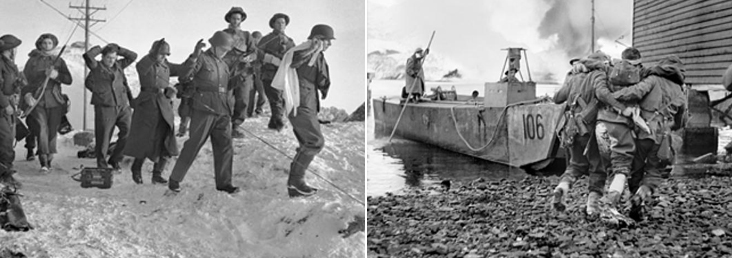I Was There! - With Unbelievable Suddenness the Barham Sank
The War Illustrated, Volume 5, No. 121, Page 502, February 20, 1942.
Told by Capt. C. E. Morgan of the Valiant to Massy Anderson, Reuter's special correspondent, this dramatic story of H.M.S. Barham's sinking off Sollum on Nov. 25, 1941, has a tragic interest in that Mr. Anderson himself went down in the Galatea a few weeks later.
It was like something one sees on the films [Captain Morgan of the Valiant said to Reuter's correspondent, Massy Anderson]. The 35,000-ton ship disappeared with unbelievable suddenness; it was only 4 minutes 35 seconds exactly from the moment the torpedoes struck until she had completely disappeared.
Our battleships were proceeding westwards line ahead, with the Valiant immediately astern the Barham and with a destroyer screen thrown out ahead of the battle fleet. At 4.23 p.m., carrying out a normal zigzag, we turned to port together, thus bringing the ships into echelon formation.
Suddenly, at 4.25, I heard a loud explosion, followed by two further explosions a couple of seconds later. Fountains of water and two enormous columns of smoke shot skywards. The smoke formed an enormous mushroom, gradually enveloping the whole of the Barham, except the after part, which was subsequently also blotted out as the ship slid into a vast pall of smoke.
As the explosions occurred the officer on watch gave the command "Hard to port", to keep clear of the Barham.
Fifteen seconds later I saw a submarine break the surface, possibly forced there by the explosion. Passing from left to right, the submarine was apparently making to cross the Valiant's bows between us and the Barham. He was only about seven degrees off my starboard bow and 150 yards away, though he must have fired his torpedoes from about 700 yards.
As the periscope and then the conning-tower appeared I ordered "Full speed ahead, hard starboard." But, with the helm already hard to port, I was unable to turn quickly enough to ram him before he crash-dived only 40 yards away on our starboard side. The submarine was visible for about 45 seconds, and, simultaneously with our ramming efforts, we opened fire with our starboard pom-poms. He was so close, however, that we were unable to depress the guns sufficiently and the shells passed over the conning-tower.
I then gave the order "Amidships", again to avoid turning into the Barham, which was still under way with her engines running but listing heavily to port. As we came up on her beam she heeled further about 20 or 30 degrees, and through the smoke I could see all her quarter-deck and forecastle. Men were jumping into the water and running up on the forecastle.
The Barham was rolling on a perfectly even keel with neither bows nor stern sticking into the air. For one minute she seemed to hang in this position; then, at 4.28, she suddenly rolled violently, her mainmast striking the surface of the sea sharply a few seconds later.
I saw water pouring into her funnels. There followed a big explosion amidships, from which belched black and brown smoke intermingled with flames. Pieces of wreckage, flung high into the air, were scattered far and wide, the largest piece being about the size of my writing-desk. I immediately ordered "Take cover" as the wreckage started flying, and that was the last we saw of the Barham, which had run almost a mile since the moment she was hit.
When the smoke cleared the only signs left were a mass of floating wreckage.
The screening destroyers, which were some distance ahead of the battleships, sped back and dropped depth charges, while the others picked up survivors. The destroyer flotilla leader, Jervis, came racing down my starboard side asking for the submarine's position, but by this time we had drifted a long way past the spot where he dived, and it was impossible to give the exact location.
I think the torpedoes struck between the mainmast and the funnel, and the final explosion was probably the six-inch magazine going up, as the explosion was not loud enough for 15-inchers. Had it been the latter I should probably not be here myself, as we were only three cables (600 yards) distant.
The speed with which the Barham sank led to a heavy toll of lives, some 700 being lost. Many of the 600 survivors had remarkable escapes. Some were blown high into the air from inside the ship. Vice-Admiral Sir Henry Pridham-Wippell, whose flag the Barham was flying, was picked up after being an hour in the water. He had escaped by climbing into the water down the starboard glacis. The Barham's captain, Capt. G. C. Cooke, and most of the senior officers were all killed.
Previous and next article from I Was There!
I Was There! - We Went to Vaagso with the Commando Men
On December 27, 1941, for the first time British soldiers, sailors and airmen combined in an assault on the Nazi-occupied European coastline. Their raid on the Norwegian island of Vaagso is here descr
I Was There! - Grim Was Our Flight From the Doomed City
The majority of the British women and children were evacuated from Singapore before the final Japanese assault. From The Daily Mail correspondent, Cedric Salter, came this impression of the scene on o
Index
Previous article
Russia Has Tank-Busters - Where Are Ours?
It was recently stated in "The Times" that: "Tanks in the open have proved that they cannot at present be dominated by opposing air arm. No doubt the tacticians of the air have not shot their bolt; po
Next article
Strange Adventure of a Sunderland's Crew
Four miles off the coast of Cyrenaica a Sunderland flying-boat crashed into the sea after an engagement with two Messerschmitts, one of which was shot down. The crew were blown to the shore on a wing




